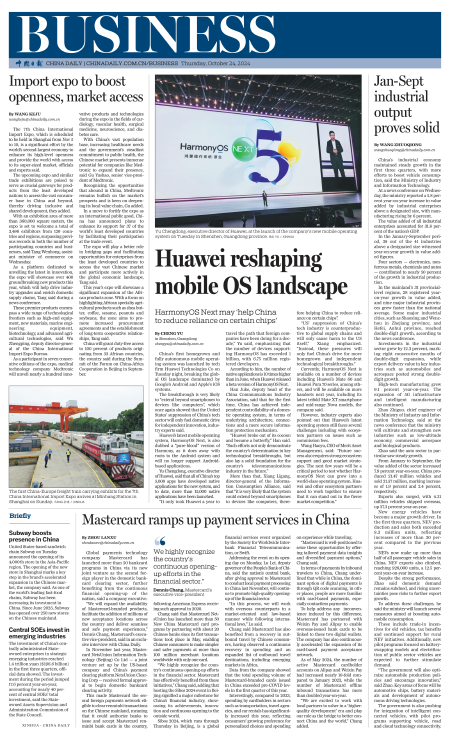China's industrial economy maintained steady growth in the first three quarters, with more efforts to boost vehicle consumption, said the Ministry of Industry and Information Technology.
At a news conference on Wednesday, the ministry reported a 5.8 percent year-on-year increase in value added by industrial enterprises above a designated size, with manufacturing rising by 6 percent.
The value added of all industrial enterprises accounted for 31.8 percent of the nation's GDP.
In the January-September period, 38 out of the 41 industries above a designated size witnessed year-on-year growth in value added figures.
Four sectors — electronics, nonferrous metals, chemicals and autos — contributed to nearly 50 percent of the growth in industrial production.
In the mainland's 31 provincial-level regions, 28 registered year-on-year growth in value added, and nine major industrial provinces grew faster than the national average. Some major industrial cities, such as Shaoxing and Wenzhou in Zhejiang province, and Hefei, Anhui province, reached double-digit growth, according to the news conference.
Investments in the industrial sector grew by 12.3 percent, marking eight consecutive months of double-digit expansion, while export delivery value in key industries such as automobiles and aerospace posted strong double-digit growth.
High-tech manufacturing grew 9.1 percent year-on-year. The expansion of 5G infrastructure and intelligent manufacturing also continued.
Zhao Zhiguo, chief engineer of the Ministry of Industry and Information Technology, said at the news conference that the ministry will cultivate and strengthen new industries such as low-altitude economy, commercial aerospace and biological products.
Zhao said the auto sector in particular saw steady growth.
From January to September, the value added of the sector increased 7.9 percent year-on-year. China produced 21.47 million vehicles and sold 21.57 million, marking increases of 1.9 percent and 2.4 percent, respectively.
Exports also surged, with 4.31 million vehicles shipped overseas, up 27.3 percent year-on-year.
New energy vehicles have become a major growth driver. In the first three quarters, NEV production and sales both exceeded 8.3 million units, reflecting increases of more than 30 percent compared to the previous year.
NEVs now make up more than half of all passenger vehicle sales in China. NEV exports also climbed, reaching 928,000 units, a 12.5 percent year-on-year increase.
Despite the strong performance, Zhao said domestic demand remains subdued, and rising uncertainties pose risks to further export growth.
To address these challenges, he said the ministry will launch several measures aimed at boosting automobile consumption.
These include trade-in incentives for old vehicles, tax benefits and continued support for rural NEV initiatives. Additionally, new pilot programs focused on battery-swapping models and electrification of public sector vehicles are expected to further stimulate demand.
"The government will also optimize automobile production policies and encourage innovation," said Zhao. Key areas of focus will be automotive chips, battery materials and development of autonomous driving technologies.
The government is also pushing for integration of intelligent connected vehicles, with pilot programs supporting vehicle, road and cloud technology connectivity.
wangzhuoqiong@chinadaily.com.cn

